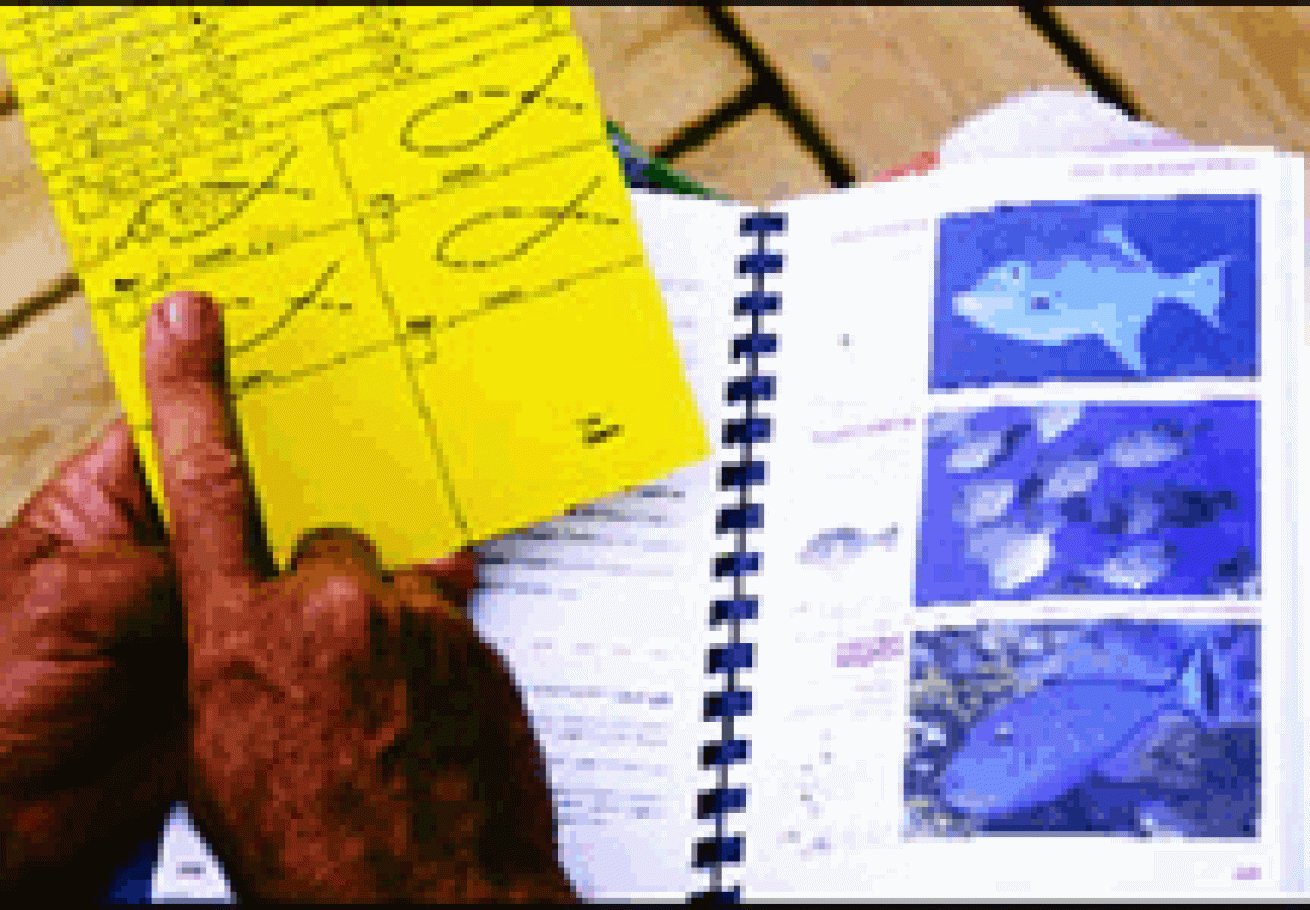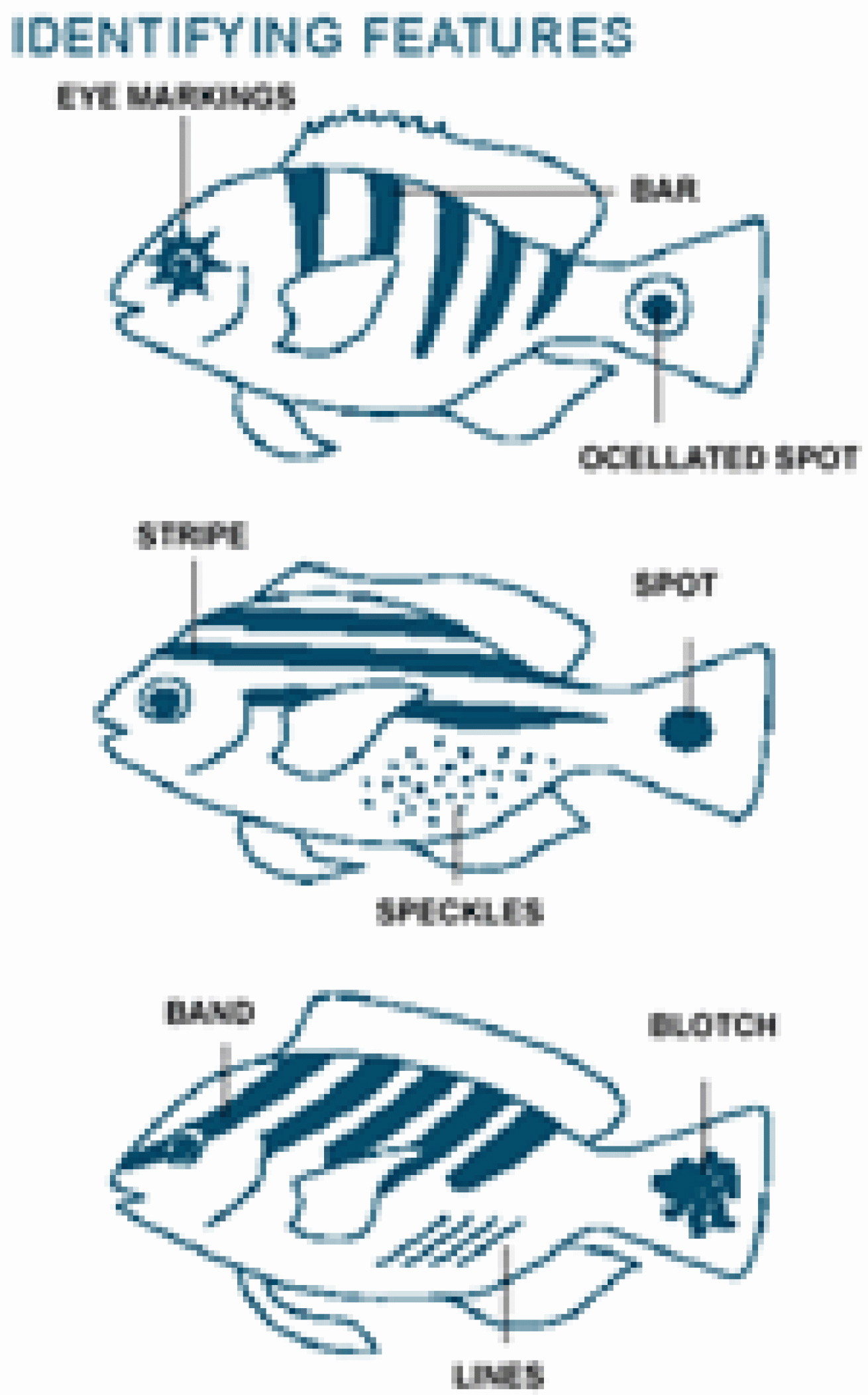Find More Fish: Eight Divemaster Secrets
 |
May 2002
By John Francis
Hey, did you see all those flashlight fish?"
"Cool! And that cloud of yellowhead wrasse? Great dive!"
Don't you just hate that? You saw nothing but the usual background reef, but it seems like everybody else saw all kinds of exotic creatures you've never heard of? And let's not even mention the divemaster who conjures an underwater rabbit out of a coral hat whenever he wants to. How do they do that?
We asked professional fish finders for their tricks. Now the secrets of the masters can be revealed:
SECRET TRICK #1 - Go Slow
"Too many people rush around as if they were driven to see everything on the reef at once," says Paul Humann, photographer and editor of the Reef Fish Identification books. "As a result, they don't see anything." Many of the life forms are pretty well camouflaged so their predators won't see them. Not surprisingly, you don't see them either. But their movement will attract your eye and give them away. If you go slow, and even stop from time to time, you can watch one area of reef long enough to pick up the movements of life. "Whoa! Where did he come from?" He was there all the time.
SECRET TRICK #2 - Look in the Right Place
Remember the joke about the drunk who looks for his wallet under the lamppost because the light is better there? Many divers do the same thing, following the attractive coral formations and only looking there for fish. But you're not going to find a yellowhead jawfish, for example, on top of the coral. It will be in an otherwise uninteresting sandy area, its head sticking out of its hole. Learn not only the fish but its specific habitat, so you know where to look.
SECRET TRICK #3 - Take a Slate
||
|---|
|

|
Have you ever seen an unusual fish and promised yourself you'd look it up in the book after the dive, but by that time you couldn't quite remember what it looked like? Carry a slate. Sketch the fish or critter and indicate unusual shapes, markings and colors. You will probably find that the act of making the sketch will itself improve your memory because it forces you to select and describe what's distinctive.
SECRET TRICK #4 - Learn Families
A fundamental step in understanding anything is to impose order on the chaos. Learn to recognize the large families and types of fish, for example, and you've both narrowed down your search in the identification book and nailed down some of its characteristics in your mind. "I know it's a butterflyfish, but what kind? What's unusual about this one?"
SECRET TRICK #5 - Connect Names and Faces
||
|---|
|

|
A name is a memory hook. When you know the names of some fish and other creatures, you can mentally put them aside and better notice the strangers. We are verbal animals, and naming things is a way of imposing order on the world. You keep seeing the same fish with a yellow tail? Learn that it's called a yellowtail snapper and your eye, and mind, can move on to something else.
-
Reef Environmental Education Foundation (REEF) promotes field surveys by sport divers. The REEF web site lists common fish for various areas, with pictures, identifying marks and behaviors. Check out the ID quiz for common fish and test your knowledge. Web: www.reef.org.
-
Reef Fish Identification by Paul Humann. The leading series of guidebooks to reef fish around the world. Also available are guides to corals and invertebrates, a CD-ROM and a lot of information on the web site: www.fishid.com.
Think of a computer analogy: Giving a document a name allows you to file it, get it off your desktop and deal with something else.
SECRET TRICK #6 - Learn the Terms
There is a terminology of fish markings that makes descriptions more precise. For example, a thick vertical line is called a bar, a thick horizontal line is stripe, a thick diagonal line is a band, and a thin line is a line. Which one is it? To decide, you have to notice the line's orientation--a detail you might otherwise have missed. Once you've named it, you're more likely to remember it.
SECRET TRICK #7 - Focus on a Few
Don't expect to identify 20 new fish on one dive. If you try to look for 20, you'll probably confuse them and not see any. Instead, focus your search on two or three new creatures until you've learned to spot them and name them. Then, you can add two or three more to your repertoire.
SECRET TRICK #8 - Have a Search Image
Study the ID book before you dive, not just after. Know which fish you might find in the area and develop what Laddie Akins, director of the Reef Environmental Education Foundation (REEF), calls a "search image" before you get wet. Commit to memory, or even write on a slate, the size, shape, color and markings of your target and, just as important, its behavior and habitat. Does it hide in the kelp or swim outside it? Is it likely to be deep or shallow?
Bonus Trick of the Divemasters: Home Field Advantage
One of the biggest reasons the dive guide can find that unusual creature is that he's been to the same site a thousand times. Many fish are territorial, and when you've found them once, you'll find them again in the same place. (So that's how they do it!)
Fish-Finder Resources

May 2002
By John Francis
Hey, did you see all those flashlight fish?"
"Cool! And that cloud of yellowhead wrasse? Great dive!"
Don't you just hate that? You saw nothing but the usual background reef, but it seems like everybody else saw all kinds of exotic creatures you've never heard of? And let's not even mention the divemaster who conjures an underwater rabbit out of a coral hat whenever he wants to. How do they do that?
We asked professional fish finders for their tricks. Now the secrets of the masters can be revealed:
SECRET TRICK #1 - Go Slow
"Too many people rush around as if they were driven to see everything on the reef at once," says Paul Humann, photographer and editor of the Reef Fish Identification books. "As a result, they don't see anything." Many of the life forms are pretty well camouflaged so their predators won't see them. Not surprisingly, you don't see them either. But their movement will attract your eye and give them away. If you go slow, and even stop from time to time, you can watch one area of reef long enough to pick up the movements of life. "Whoa! Where did he come from?" He was there all the time.
SECRET TRICK #2 - Look in the Right Place
Remember the joke about the drunk who looks for his wallet under the lamppost because the light is better there? Many divers do the same thing, following the attractive coral formations and only looking there for fish. But you're not going to find a yellowhead jawfish, for example, on top of the coral. It will be in an otherwise uninteresting sandy area, its head sticking out of its hole. Learn not only the fish but its specific habitat, so you know where to look.
SECRET TRICK #3 - Take a Slate

Have you ever seen an unusual fish and promised yourself you'd look it up in the book after the dive, but by that time you couldn't quite remember what it looked like? Carry a slate. Sketch the fish or critter and indicate unusual shapes, markings and colors. You will probably find that the act of making the sketch will itself improve your memory because it forces you to select and describe what's distinctive.
SECRET TRICK #4 - Learn Families
A fundamental step in understanding anything is to impose order on the chaos. Learn to recognize the large families and types of fish, for example, and you've both narrowed down your search in the identification book and nailed down some of its characteristics in your mind. "I know it's a butterflyfish, but what kind? What's unusual about this one?"
SECRET TRICK #5 - Connect Names and Faces

A name is a memory hook. When you know the names of some fish and other creatures, you can mentally put them aside and better notice the strangers. We are verbal animals, and naming things is a way of imposing order on the world. You keep seeing the same fish with a yellow tail? Learn that it's called a yellowtail snapper and your eye, and mind, can move on to something else.
Think of a computer analogy: Giving a document a name allows you to file it, get it off your desktop and deal with something else.
SECRET TRICK #6 - Learn the Terms
There is a terminology of fish markings that makes descriptions more precise. For example, a thick vertical line is called a bar, a thick horizontal line is stripe, a thick diagonal line is a band, and a thin line is a line. Which one is it? To decide, you have to notice the line's orientation--a detail you might otherwise have missed. Once you've named it, you're more likely to remember it.
SECRET TRICK #7 - Focus on a Few
Don't expect to identify 20 new fish on one dive. If you try to look for 20, you'll probably confuse them and not see any. Instead, focus your search on two or three new creatures until you've learned to spot them and name them. Then, you can add two or three more to your repertoire.
SECRET TRICK #8 - Have a Search Image
Study the ID book before you dive, not just after. Know which fish you might find in the area and develop what Laddie Akins, director of the Reef Environmental Education Foundation (REEF), calls a "search image" before you get wet. Commit to memory, or even write on a slate, the size, shape, color and markings of your target and, just as important, its behavior and habitat. Does it hide in the kelp or swim outside it? Is it likely to be deep or shallow?
Bonus Trick of the Divemasters: Home Field Advantage
One of the biggest reasons the dive guide can find that unusual creature is that he's been to the same site a thousand times. Many fish are territorial, and when you've found them once, you'll find them again in the same place. (So that's how they do it!)
Fish-Finder Resources
Reef Environmental Education Foundation (REEF) promotes field surveys by sport divers. The REEF web site lists common fish for various areas, with pictures, identifying marks and behaviors. Check out the ID quiz for common fish and test your knowledge. Web: www.reef.org.
Reef Fish Identification by Paul Humann. The leading series of guidebooks to reef fish around the world. Also available are guides to corals and invertebrates, a CD-ROM and a lot of information on the web site: www.fishid.com.










